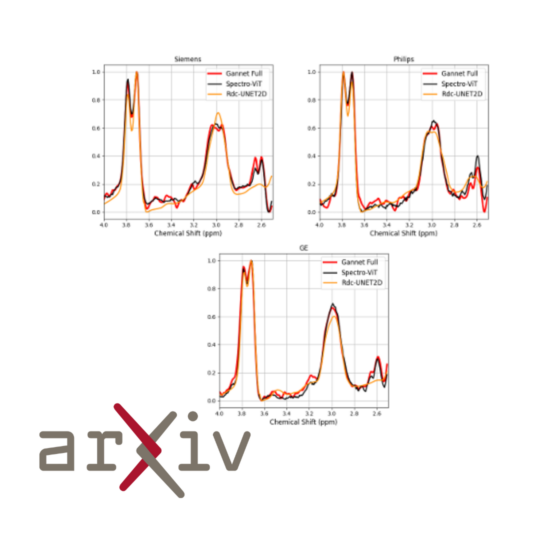
Spectro-ViT: A Vision Transformer Model for GABA-edited MRS Reconstruction Using Spectrograms
arXiv:2311.15386v1 [eess.IV] 26 Nov 2023
In continuation of recent research efforts in the literature, this study delves deeper into the potential of DL for reducing scan time in MEGA-PRESS for GABA measurement, introducing an enhanced state-of-the-art DL model that secured the first-place solution in the edited-MRS reconstruction challenge. The contributions of this paper are as follows:
• State-of-the-art model: A state-of-the-art model that addresses the trade-off in signal averaging for MEGA-PRESS in GABA measurement. The proposed DL model has achieved better reconstruction metrics than the one developed by Berto et al. It also secured the first-place solution in the Edited-MRS reconstruction challenge for reconstructing GABA MEGA-PRESS scans using only 80 transients.
• Exploration of the spectrogram domain: the successful use of features extracted from the spectrogram domain to train a DL reconstruction model, showcasing a promising alternative for MRS related tasks. While previous models in the MEGA-PRESS literature typically chose either a frequency or time domain representation as input, the proposed approach explores the spectrogram’s ability to balance these two aspects.
• Vision Transform (ViT): The use a ViT model to solve a MRS problem. A recent literature review provides a comprehensive overview of machine learning applications in MRS, revealing a lack of Transformer models in this domain. The review emphasizes the importance of exploring different and novel model types, including Transformers, which have demonstrated potential in other medical imaging fields. Therefore, this work pioneers the use of the Transformer model, marking its first application in MRS research. By leveraging the capabilities of the ViT, this study aims to unlock new possibilities and insights in MRS analysis, potentially enhancing its performance and opening methods for further advancements.
• Quantification Investigation: This study presents the first investigation of spectra quantification analysis in GABA MEGA-PRESS DL-based reconstruction and goes beyond reconstruction metrics. Statistical analysis and data visualization demonstrate that the proposed model by this work yields metabolite concentration estimation comparable to those of the conventional pipeline, which uses 320 transients.
• Transients Subset Analysis: In this study, 320 transients were analyzed by dividing them into four groups, each representing a quarter of the data acquisition process. This division allows to assess the robustness of the innovative ViT model in addressing common challenges in MEGA-PRESS spectral analysis, such as frequency and phase misalignment caused by subject movement. The model’s stability was evaluated by analyzing transients 1-80, 81- 160, 161-240, and 241-320, which simulated different levels of spectral quality. The consistent results across these groups demonstrated the method’s robustness.
• Share of code and model: By openly share its findings and code, this work intends to facilitate easy reuse and to encourage further similar research in the future.
Full paper here: https://doi.org/10.48550/arXiv.2311.15386
Publication Info
- Authors: Gabriel Dias, Rodrigo Pommot Berto, Mateus Oliveira, Lucas Ueda, Sergio Dertkigil, Paula D. P. Costa, Amirmohammad Shamaei, Roberto Souza, Ashley Harris, Leticia Rittner
- How to cite: DIAS, Gabriel et al. Spectro-ViT: A Vision Transformer Model for GABA-edited MRS Reconstruction Using Spectrograms. arXiv preprint arXiv:2311.15386, 2023.
- Published: 26 November 2023


